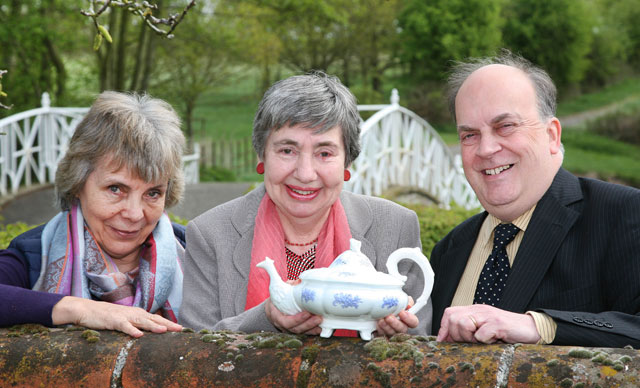When a German bombing raid flattened one of the farmhouses at the Marks Hall Estate near Coggeshall during the Second World War three people were dug out alive and the only object to survive was a teapot.
That battered teapot has survived another seven decades as an heirloom treasured by a local family and is just one of the pieces of historic evidence gathered by a research team from the Department of History at the University of Essex looking to piece together the history of the Marks Hall site from Saxon times through to the present day.

Dr Jane Pearson, Cynthia Williams and Professor James Raven at Marks Hall Estate.
Marks Hall, which was demolished in the 1950s, is one of the lost great mansions of Britain and now the site of the Marks Hall Gardens and Arboretum. Its colourful history includes playing an important role in the Second World War as an Area Headquarters for the RAF and then the United States Ninth Air Force.
This week the research team brought together many of the people who have taken part in oral history interviews as part of the project. They joined representatives from local authorities for a local history seminar and public policy forum at the site titled ‘Memory and the Marks Hall Mansion’.
One of those attending was Cynthia Williams, from Coggeshall, who inherited the teapot. She said: “My grandparents were bombed out of their farmhouse on the Marks Hall Estate and lost everything.
“My father Jack and his brother Harry went to dig them out and thought they were dead, but then they heard scratching and they were able to rescue my grandparents James and Emily Bowers and their grandson Douglas. The only thing to come out from the ruins of the house was this teapot. It’s cracked, but still intact.
“I kept it because I thought it would be sad to throw it out. It is nice that it is going back to Marks Hall to be put on display.”
At the seminar and policy forum the research team talked about the findings so far and the challenges of bringing all the varying perspectives together to present an authoritative interpretation of the history of the site.
Knowledge Exchange Officer Ian Yearsley said: “We have had a tremendous response from the public which shows the mansion has a very special place in the heart of many people.
“The day explored the concept of memory and history because we have found that people have conflicting recollections about the mansion.”
Dr Jane Pearson, from the Department of History, has led the research work gathering oral history accounts and talked about what it tells us about the changing landscape at the site. Dr Gabriel Moshenka from University College London discussed the role of memory-work in the archaeology of the Second World War. Meanwhile, Professor James Raven, who is overseeing the whole project, hosted the day.
Mr Yearsley said: “This has been a real collaborative project and everyone has been very supportive.
“For example, the archaeological team has been so enthusiastic and they worked through the winter as they just wanted to keep digging and finding things. We have also been able to bring a lot of experts to the site to discuss conservation.”
The project team hope their work will eventually be used to establish a museum and interpretation centre to tell the story of the lost mansion and the people who lived and worked there.
Background information
The Jacobean mansion known as Marks Hall fell into disuse after being used as a military base in the Second World War and before being demolished its entire contents from roof tiles and floorboards to its Jacobean panelling, staircases and fireplaces and family portraits were sold off by auction.
The gardens of the estate were eventually restored and are now open to the public and the Marks Hall Estate, the charity which manages the estate, is keen to reconstruct the history of the site for visitors.
The research project led by Professor Raven is supported by a grant from the Economic and Social Research Council (ESRC) and is looking to find new ways of reconstructing a site’s history to ignite the imagination of the visiting public. The local community and general public are being encouraged to work with academics and heritage, archaeology and horticultural professionals to help develop a virtual recreation of the lost heritage site.
The project has also provided short term research posts for graduates from the Department of History - providing valuable experience of working on a major research project.
Since last year historical researchers have been looking through records and gathering personal recollections, while members of the Colchester Archaeological Group (CAG) have been searching for physical traces of the Hall and the evidence left behind by its occupants over many centuries. Community dig days, which allow members of the public to visit the site to learn more about the work of the archaeologists, have also been incredibly popular.
So far the archaeological dig has made several important discoveries including the site of the brick cellar, the drains which help outline the layout of the now demolished buildings and a substantial cistern for water storage. Individual artefacts have also been found including the remains of a pot thought to date back to the 13th century, a ceiling rose, the servant bell system and an iron fireguard.